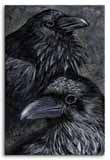|
|
|||||

|
Hugin and Mugin Two ravens sit on his shoulders and speak into his ear all the news they see or hear. Their names are Hugin and Munin. He sends them out at dawn to fly over all the world and they return at dinner-time. As a result he gets to find out about many events. (Snorri, 33) In the myth of Odin's two ravens, Hugin (from Old Norse hugr "thought") and Munin (from Old Norse munr "memory"), we find thought and memory linked together as complimentary but separate entities. In these two ravens I see a mythic representation of the connection between thought and memory. Our ability to think allows us to access and make use of our memories. And our memories, whether they are naturally or artificially stored, represent that which we know, what we call knowledge. Just as Hugin and Munin are separate but closely related entities, thought and memory are discrete but connected cognitive functions.Thought allows us to make use of our memories by means of reminiscentia, while at the same time our memories serve as a machina memorialis, as the engine of thought. This legend is at least as old as the 13th Century when Snorri wrote the Prose Edda. We also find reference to the ravens in the thirteenth-century Codex Regius, the manuscript which contains the peom "Grímnismál," "Grimnir's Sayings." We know, however, that the Codex Regius is a copy of another manuscript and it is believed many of the poems are much older than the thirteenth-century manuscript date. Likewise, exactly how far back Hugin and Munin date is unclear, but images of Odin and his two ravens are found in art dating to the Migration Period (ca. 400 - 600 CE). The raven image, titled "Hugin and Munin," is by Amy L. Rawson and is used with permission. It and her other artwork can be found at thirdroar.com. Works Cited Snorri Sturluson. Edda. Trans. Anthony Faulkes. London: J.M. Dent & Sons, 1987. |
||||
|
|||||